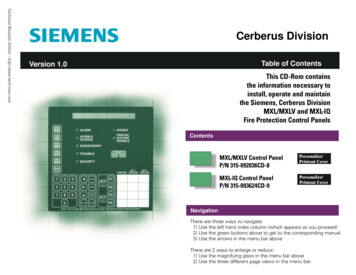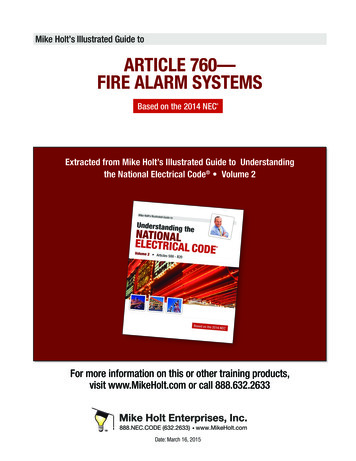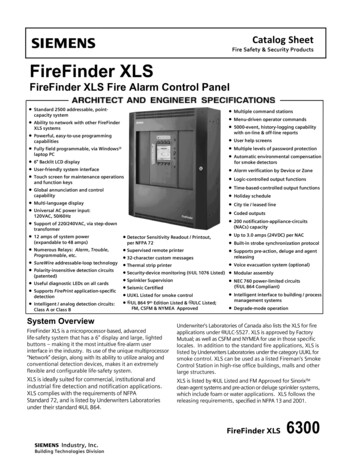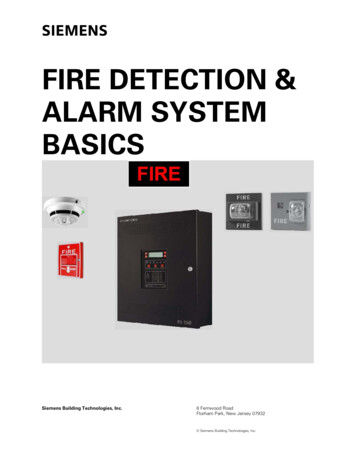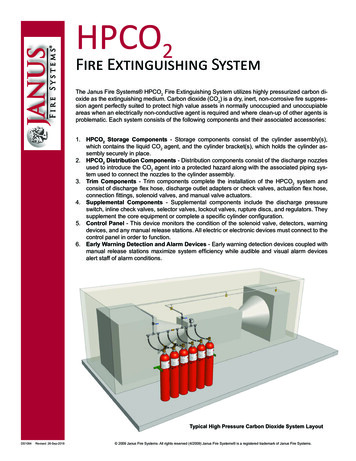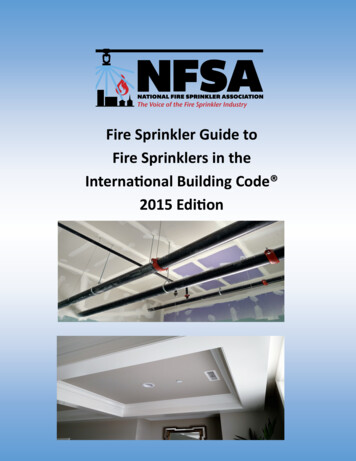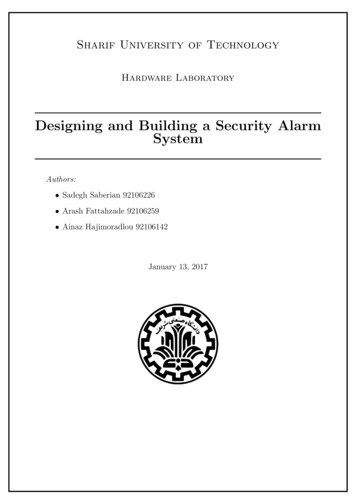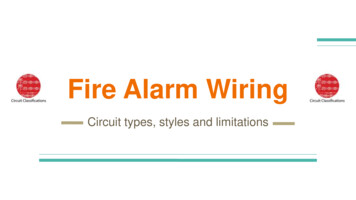
Transcription
Fire Alarm WiringCircuit types, styles and limitations
What we will cover Types Classes Notification Appliance Circuits (NAC)Initiating Device Circuits (IDC)Signaling Line Circuits (SLC)Class A, B, C, D, E, & XSurvivabilityLimitations Attendee Discussion Questions and AnswersWhat to watch out for in the real world Capacitance Voltage Drops Power Limited vs Non-Power Limited
Types Notification Appliance Circuits/Control Circuits (NAC) Supervised polarity reversing power circuits for Horns, Strobes, Bells, ChimesAny NAC that does not have a Notification Appliance attached shall be considered a ControlCircuitPerformance shall be based upon wiring Class (Note the old Class & Style has been replacedwith Class only)Troubles (Opens, Shorts or Grounds) must be reported within 200 secondsAlarms must activate NACs and Control circuits within 10 secondsSurvivability, an Open, Short or Ground cannot affect any other NAC for more than 200secondsFaults on Addressable Notification Devices that are in different “notification Zones” but on thesame SLC can not interfere with those in other notification zones.
Types Continued Initiating Device Circuits (IDC) A circuit where Automatic or Manual Initiating Devices are connected and the signal does NOTidentify the individual device operated.Performance shall be based upon wiring Class (Note the old Class & Style has been replacedwith Class only)Alarms must activate NACs and Control circuits within 10 secondsTroubles (Opens, Grounds) must be reported within 200 secondsNo more than 5 Waterflow devices and no more than 20 Supervisory devices per IDC
Types Continued Signaling Line Circuits (SLC) A circuit where any combination of addressable devices connect to system interface containingboth input and/or output signalsPerformance shall be based upon wiring Class (Note the old Class & Style has been replacedwith Class only)Troubles (Opens, Shorts or Grounds) must be reported within 200 secondsAlarms must activate NACs and Control circuits within 10 secondsSurvivability, an Open, Short or Ground cannot affect any other SLC Controlled NAC for morethan 200 secondsFaults on Addressable Notification Devices that are in different “notification Zones” but on thesame SLC can not interfere with those in other notification zones.
Types Continued Initiating Device Circuits (IDC) A circuit where Automatic or Manual Initiating Devices are connected and the signal does NOTidentify the individual device operated.Performance shall be based upon wiring Class (Note the old Class & Style has been replacedwith Class only)Alarms must activate NACs and Control circuits within 10 secondsTroubles (Opens, Grounds) must be reported within 200 secondsNo more than 5 Waterflow devices and no more than 20 Supervisory devices per IDC
Class A Class A has the benefit of a redundantpathway back to the control panel.That pathway assures that any signal isreceived at the control panel.This wiring Class applies to NAC, IDC andSLC (except the SLC with Short CircuitIsolation)The NFPA 72 2013 recognizes the use ofFiber Optic cable and is not affected byshorts of grounds.
Class B Class B has no redundant pathway backto the control and as such is moresusceptible to wiring faults.This wiring Class applies to NAC, IDC andSLC
Class C, D & E System integration is addressed in ClassesC, D & E.Class C is for wired Ethernet devices wherethe pathway is not as important as thecommunication between both ends of thepathway. (NFPA 72 2016 introduces Class Nwhich is a 4 wire [Class A like] wiringmethod)Class D is for FailSafe operating circuitsClass E is for ancillary “Non-Supervised”circuits
Class X Class X is the new designation for SLCStyle 7 wiringIncludes a Class A like redundant pathwayIt is supposed to allow the circuit to remainfunctional even with a wire-to-wire short
Survivability The level of survivability required is dependent on the type of fire alarmsystem being installed. A higher level of survivability applies to systems usedfor relocation or partial evacuation of occupantsLevels of Survivability are 1 - 3, depending on if the wiring is within anEvacuation Signaling Zone (ESZ) or notAn ESZ is a discrete area of a building, bounded by smoke or fire barriers inwhich occupants are intended to relocate or evacuate.Level 0 means no survivability is required (wiring within the ESZ)Level 1 - 3 indicate that attack by fire shall not impair the control andoperation of Notification Appliances outside the ESZ
Survivability Continued The Key Concept behind Levels 1 -3 is the Fact that Metal Raceway onlyprotects wiring against Mechanical Damage, NOT Damage by Fire.Level 1, In buildings that are protected by an Automatic Sprinkler System andwho’s wiring is installed in Metal RacewaysLevel 2 can be accomplished by, A, 2-hour rated CI Wire ORB, 2-hour fire rated cable system ORC, 2-hour fire rated enclosure ORD, 2-hour performance alternative approved by the AHJLevel 3, a combination of Levels 1 & 2.
Survivability Continued When attack by fire will affect signaling and control outside of the ESZ, thenpathway survivability Levels 2 - 3 are used (at the discretion of the AHJ)When the wiring outside of the ESZ is necessary for the operation and controlof Notification Appliances until it enters the ESZ, Level 2 - 3 must be usedCI rated Cables may be used where pathway survivability Level 2 - 3 isrequired.CI Cables are not required for Levels 0 - 1.Follow NEC 760 and the AHJ’s guidance
Let’s talkQuestions?Field issues?What’s next in this series of Fire Alarm Tech Presentations
protects wiring against Mechanical Damage, NOT Damage by Fire. Level 1, In buildings that are protected by an Automatic Sprinkler System and who’s wiring is installed in Metal Raceways Level 2 can be accomplished by, A, 2-hour rated CI Wire OR B, 2-hour File Size: 325KBPage Count: 14
